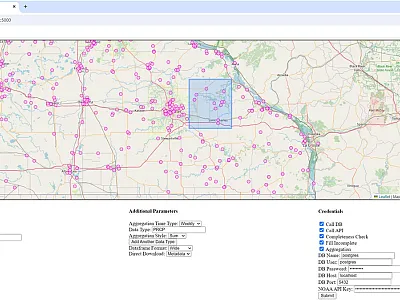How to Grow the World’s Most Expensive Spice
New Research Untangles the Many Factors Influencing Saffron Yield
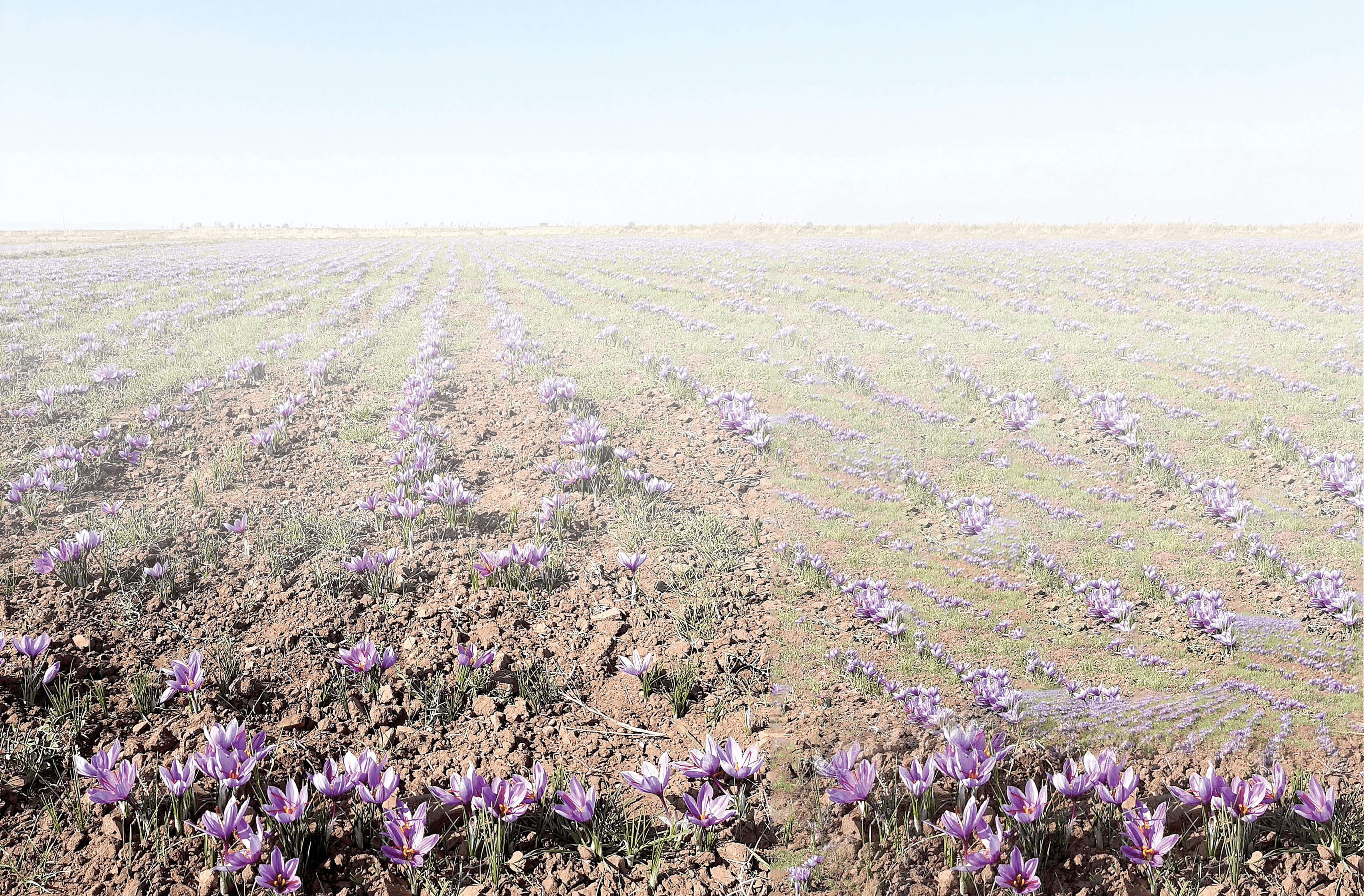
Saffron is the most expensive spice in the world because of the laborious hand‐harvesting and processing it requires. New research in Agrosystems, Geosciences & Environment comprehensively evaluates the many environmental and climate factors impacting saffron yield in Iran, and researchers and farmers in North America are testing how well the spice can be grown in atypical climates.
Video summary
In the spice aisle at my local supermarket, a glass jar containing 0.06 oz, or about 1.7 g, of saffron costs a whopping $21.99. Sometimes called “red gold” because of its vibrant hue and high value, saffron is the most expensive spice in the world. It lends dishes a sweet, earthy flavor, and its crimson color dilutes to give curries, rice, and stews a beautiful golden tint. It’s also used as a fabric dye and as a health supplement. Legend has it that Alexander the Great used it to perfume his bathwater.
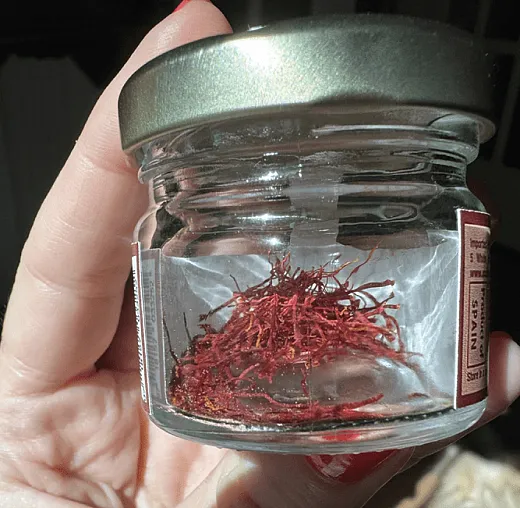
Saffron is so expensive—as much as $9,000 a pound in trade—in part because it requires hand‐harvesting and processing. Long grown in Asia and Europe, researchers in North America have begun studying how saffron can help small growers diversify their cropping systems. In this article, we dig into new research published in Agrosystems, Geosciences & Environment (AGE) probing the many environmental and climate factors impacting saffron yield in Iran, the top global producer of the spice, and touch base with a research program working to help farmers in the United States and Canada grow it.
Iran’s Red Gold
The saffron spice is made of the stigmas of the flower Crocus sativus, a perennial from the Iridaceae family with lovely purple petals. The tangle of stigmas that ends up bottled in the supermarket spice aisle, known as saffron “threads,” are typically brilliant red in color with a sunset orange tip and have been plucked out of the flowers and dried before use.
Cultivated since antiquity, Crocus sativus is possibly descended from Greece‐ and Crete‐native Crocus cartwrightianus and is a sterile triploid with eight trios of chromosomes, requiring cross‐pollination. The flower grows from corms (solid, spherical underground stems), which develop secondary or daughter corms that producers can dig up to propagate. Its flowers are sterile and don’t produce seeds; its offspring are clones of the parent plant.
“This lack of [genetic] diversity hinders significant improvements through traditional breeding,” explains Hadi Pirasteh‐Anosheh, a researcher at the Agricultural Research, Education, and Extension Organization (AREEO) in Iran. Instead, most research today focuses on improving management and testing which environmental conditions are ideal for boosting yield. Corm size and quality, fertilization and irrigation practices, and planting date all affect yield as do air temperature, soil moisture, and a variety of other environmental factors.
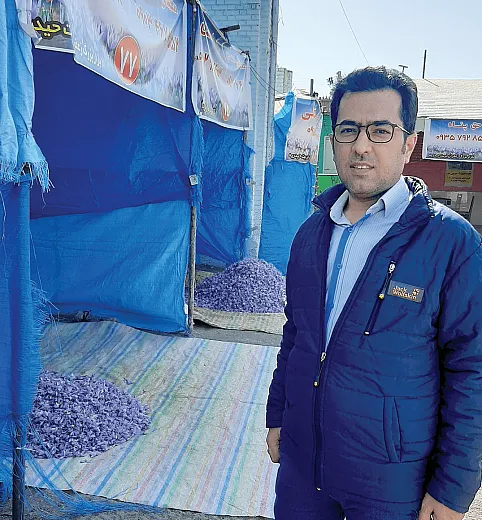
Historically, saffron has been grown in arid and semiarid regions from the Mediterranean to the Himalayas. Spain, Morrocco, Italy, and India are all major sources, but Iran is far and away the number one global producer of saffron. Exact counts are hard to come by, but the country meets more than 90% of the world’s demand for the spice.
The saffron blooming period lasts for about a month during the fall, and harvesters then head into the fields to pick them by hand. After a wintertime vegetative stage, daughter corms develop and go dormant as temperatures turn warmer. This is when they can be dug out of the earth to be planted elsewhere or left in place to sprout in the fall. In the meantime, the picked blooms are sold or processed: the stigmas are picked out, dried, and stored for subsequent sale. Once dried, the threads lose most of their mass. A 1‐ac field in Iran produces around 1.83 kg of saffron with the 1.7‐g jar I found at the store requiring around 250 flowers to create. Researchers at the University of Vermont (UVM) have found it takes around 10 minutes to pick 100 saffron flowers in the field and 20 minutes to separate those 100 flowers’ stigmas. Beds are usually replanted every four to six years.
Recent reports suggest that altered weather patterns are affecting the saffron production in Iran. In the arid and semi‐arid regions where the spice is most grown, climbing temperatures and dipping rainfall threaten yield. Even without the threats from a changing climate, most saffron fields in Iran must be irrigated to provide adequate soil moisture. The scarcity of fresh water sources in these regions means that brackish water is often used in agriculture. “Because now the situation of water resources in Iran has become critical and salinity has spread, the tendency to use saline water has increased,” says Pirasteh‐Anosheh.
Unthreading the Influence of Management and Environment
Given Iran’s major place in the global saffron market, Pirasteh‐Anosheh and his colleagues designed a wide‐ranging study of the country’s saffron‐producing areas to untangle the many environmental and management factors that influence yield. During the 2020–2021 growing season, they studied fields in 13 different regions stretching from north to south in the main saffron‐cultivation areas in the eastern and central portions of the country. They aimed to cover a variety of climate conditions: hot desert, cold desert, and semiarid climates. This comprehensive approach “allows for the development of region‐specific management practices,” Pirasteh‐Anosheh says.
The team gathered geographical information about the fields’ ages and sizes from farmers and satellites, climate information from national datasets, information on plant nutrition from farmer questionnaires, data on field irrigation, and soil characteristics out in the fields. They calculated each field’s yield and yield components by randomly sampling three 10 m2 areas for number of flowers growing within and evaluated the average weight and total weight of flowers from each.
What factors proved to be most important for fields with high yield? “In a quick answer, I would say all factors,” Pirasteh‐Anosheh says. But more granularly, temperature and soil texture, as well as field age and length of growth period, all had an important effect, the researchers reported recently in AGE (https://doi.org/10.1002/agg2.20418). The most yields were obtained from fields four to six years old. They found that lower temperatures in early fall stimulated flowering and increased the yield in that year while warm and sunny days in the spring were important for next year’s yields. Fields with coarse and balanced soil were associated with higher yields, and “irrigation frequency is more important than the irrigation volume” for high yields, Pirasteh‐Anosheh explains.
Pirasteh‐Anosheh also found that an economically viable saffron crop could be produced in semi‐saline conditions. “I believe that saffron is not the most sensitive plant to salinity as they say,” he says. He’s conducted other studies that support this statement—potentially good news as supplies of freshwater become more uncertain. “I believe that semi‐saline water can be used for saffron cultivation, provided management tips are followed in the field,” he says.
And beyond Iran, “this study … can serve as a foundation for identifying favorable regions for saffron cultivation in the USA,” Pirasteh‐Anosheh says.
The State of U.S. Saffron
In the U.S., you will find saffron farms in areas that share some of the same arid qualities as the regions studied in Iran, like California and Texas. But historically, saffron was first cultivated in U.S. among the rolling green hills of Pennsylvania Dutch country by Mennonite immigrants during the 18th century. A thriving saffron trade resulted in this region for some time. “In the years before the Revolutionary War, saffron was listed on the Philadelphia commodity exchange on a nearly weekly basis, its price calculated the same as it had always been—equal to gold,” writes Pat Willard in the book Secrets of Saffron: The Vagabond Life of the World’s Most Seductive Spice.
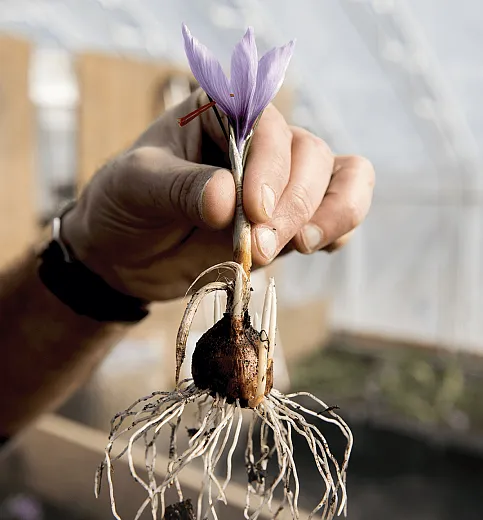
Today, New England hosts the North American Center for Saffron Research & Development at UVM. “There is a large swath of the United States where saffron could be grown,” says UVM’s Margaret Skinner. Skinner is an entomologist whose non‐saffron work is in integrated pest management. “Our mission really is to meet the needs of growers,” she says, working with them to manage agricultural pests in greenhouses and high tunnels. These tunnels are used to extend the growing season amidst unpredictable Vermont weather and typically house crops like leafy greens.
“So as is often the case, there was a glut on the market for spinach and kale,” says Skinner of the situation these farmers faced about a decade ago. Most of the farmers in the region are small, diversified growers, defined by the USDA as earning less than $350,000 in yearly gross cash farm income. “We’re always thinking, how can we help these growers to produce more crops?”
A postdoc named Arash Ghalehgolabbehbahani stepped in with a suggestion. Ghalehgolabbehbahani, who is from Iran, said they should try saffron in the high tunnels. “At first I thought it was a crazy idea,” Skinner says. She assumed the crocuses would not fare well in the snowcapped New England winters in Plant Hardiness Zones 4 and 5. But the researchers tried it out, first in the high tunnels and then outside, and found that indeed saffron could survive out in Vermont’s climate.
Over the years, Skinner and colleagues have studied many facets of saffron production in the region and have assembled a large body of knowledge for growers interested in the crop. They currently have a project testing how to protect the saffron corm from bulb mites and Fusarium infection.
Pests aside, Skinner says a major battle for farmers and researchers is the occasionally unpredictable behavior of the crop. For example, in 2022, the researchers planted a plot with corms from the Netherlands. About 75% of the plot blossomed—typical for a first‐year yield. The next year they planted an adjacent plot with corms from same source, under the same treatment, but they blossomed “like crazy”—about 100%. And the plot planted in 2022, which should have had a significant increase in blooms, produced less than half the yield of the first year.
“I don’t know why,” Skinner says of a possible explanation. “Was it because we had a cold snap in May? We had a drought in the fall, and that cold spell in the spring, and then in the summertime it rained a whole lot,” she says. “Which of all those factors influenced those corms?”
Locally Made Value
There’s still much to be learned about how saffron grows in a variety of environments and climates. Skinner suspects a large portion of the U.S. has temperatures friendly for its cultivation. “Wouldn’t it be nice to … get growers all over the United States to grow saffron and keep track of weather conditions?” she says, noting that conditions in Iran like those studied in the AGE paper may be very different from those in the U.S.
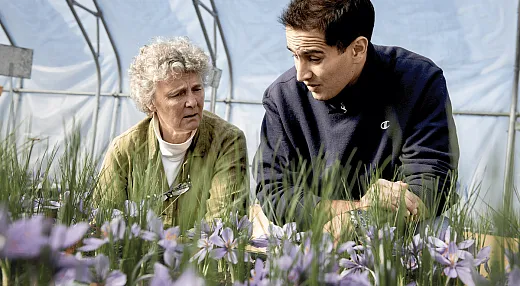
In the meantime, UVM and Skinner host an international “Saffronnet” listserv for around 900 commercial growers, home gardeners, and researchers to exchange knowledge, and she estimates there are thousands of growers across North America producing saffron. Some of the farmers she’s worked with have found that saffron fits seamlessly into their existing cropping systems, some find it “too fiddly,” and others have had trouble figuring out how to market and sell it once harvested. In the U.S., “it’s a new product. It still needs a lot of market development, which works for small, diversified farmers that sell a lot of their produce at farmers’ markets,” Skinner says.
She’s seen firsthand how valuable a “Made in Vermont” sticker on the side of a jar of saffron can be. “Vermont has a brand—it’s such a cool place,” she says, and both locals and tourists alike want to buy locally made produce and products. The same likely holds true for other locations and destinations. Because of its value, saffron is hugely vulnerable to food fraud and is often adulterated with fillers, aromas, and dyes. Purchasing local saffron could give consumers assurance that what they are buying is the real thing, especially important for saffron used as a health supplement.
And some producers have found success with the laissez‐faire attitude selling saffron allows. One grower in Pennsylvania, who has a small bed of saffron in addition to vegetables that he sells at a farmers’ market, described to Skinner how if he doesn’t sell his spinach at the market, he’ll have to throw it on the compost heap when he gets home. But if his saffron doesn’t sell: “‘That’s alright. I’ll bring it home, put it back in the drawer, and I take it out the next time,’” Skinner says of his perspective.
Therein lies a major benefit of the spice, for both producers hoping to turn a profit and home cooks who use it on occasion. “It will last easily two to three years if you take care of it right and if you dried it properly,” Skinner says. “That really is the beauty of saffron.”
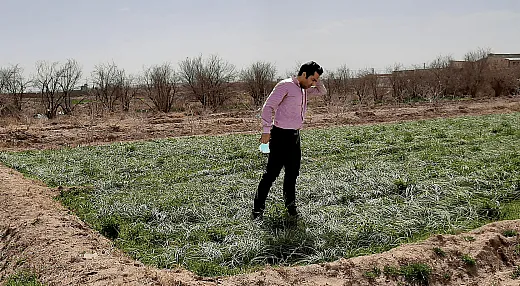
DIG DEEPER
Read the Agrosystems, Geosciences & Environment study highlighted in this story here:
Pirasteh‐Anosheh, H., Babaie‐Zarch, M.J., Nasrabadi, M., Parnian, A., Alavi‐Siney, S. M., Beyrami, H., … & Race, M. (2023). Climate and management factors influence saffron yield in different environments. Agrosystems, Geosciences & Environment, 6, e20418. https://doi.org/10.1002/agg2.20418
If you’re interested in subscribing to the Noth American Center of Saffron Research and Development’s email list Saffronet, email mskinner@uvm.edu.
Text © . The authors. CC BY-NC-ND 4.0. Except where otherwise noted, images are subject to copyright. Any reuse without express permission from the copyright owner is prohibited.




